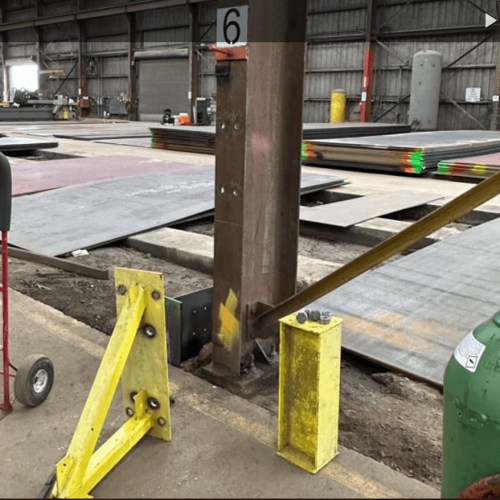Steel columns are essential components in modern buildings, providing crucial support for structures ranging from office buildings to industrial facilities. Their role in maintaining structural integrity cannot be overstated. However, like any other structural element, steel columns can experience wear and tear, corrosion, and damage over time. This blog explores why steel column repair is vital for building safety and outlines key considerations to ensure the longevity and stability of these critical elements.
The Role of Steel Columns in Building Safety
Steel columns serve as vertical supports that bear the weight of the structure above them. They transfer loads from floors and roofs down to the foundations, ensuring that the building remains stable and secure. Because they handle significant stresses, any compromise in their integrity can jeopardize the overall safety of the building.
Structural Integrity: Steel columns are designed to support substantial loads. If a column is damaged or weakened, it can fail to bear the intended load, leading to potential structural failure. This can result in serious safety hazards and costly repairs. Maintaining the integrity of steel columns is crucial to preventing accidents and ensuring the building’s safety.
Load Distribution: Proper load distribution is essential for maintaining structural balance. Steel columns help evenly distribute loads throughout the building. Any damage to a column can disrupt this balance, causing excessive stress on other parts of the structure and increasing the risk of failure.

Common Issues Affecting Steel Columns
Understanding the types of issues that can affect steel columns is the first step in recognizing the importance of timely steel column repair. Common problems include:
Corrosion: Exposure to moisture and environmental elements can cause steel columns to rust. Corrosion weakens the steel and reduces its load-bearing capacity. Regular inspections and maintenance are essential to address corrosion before it becomes a severe issue.
Physical Damage: Steel columns can suffer from physical damage due to impacts, such as those from machinery or construction activities. This damage can compromise the column’s structural integrity and necessitate immediate repair.
Wear and Tear: Over time, steel columns may experience wear and tear from regular use and stress. This gradual degradation can lead to reduced effectiveness and increased risk of failure if not addressed promptly.
Design and Construction Flaws: In some cases, steel columns may have inherent design or construction flaws. These issues can affect their performance and may require repairs or reinforcements to meet safety standards.
The Importance of Timely Steel Column Repair
Addressing issues with steel columns promptly is crucial for several reasons:
Preventing Structural Failure: The primary purpose of steel column repair is to prevent potential structural failures. Ignoring damaged columns can lead to severe consequences, including partial or complete collapse of the building. Timely repairs ensure that the columns continue to support the structure effectively.
Ensuring Safety: The safety of building occupants is paramount. Regular inspection and maintenance of steel columns help identify and address problems before they pose significant risks. Ensuring that columns are in good condition helps protect people and property.
Cost Savings: Addressing issues early can save significant amounts of money. Repairing minor damage before it escalates into a major problem is more cost-effective than dealing with extensive repairs or structural failures. Preventative maintenance can also extend the lifespan of the columns and reduce long-term expenses.
Compliance with Building Codes: Building codes and regulations require that structural elements, including steel columns, meet specific safety standards. Regular inspections and repairs help ensure compliance with these regulations, avoiding potential legal issues and fines.
Best Practices for Steel Column Repair
To maintain the safety and longevity of steel columns, it’s essential to follow best practices for repair and maintenance:
Regular Inspections: Routine inspections are crucial for identifying early signs of damage or deterioration. Inspections should be conducted by qualified professionals who can assess the condition of the columns and recommend necessary repairs.
Addressing Corrosion: For columns affected by corrosion, the affected areas should be cleaned and treated to remove rust. Protective coatings can then be applied to prevent further corrosion and extend the life of the steel.
Reinforcement and Strengthening: In cases where steel columns have been weakened or damaged, reinforcement techniques may be necessary. These can include adding additional steel plates, installing braces, or using other methods to restore the column’s load-bearing capacity.
Documenting Repairs: Keeping detailed records of inspections and repairs is essential for tracking the condition of steel columns over time. This documentation helps in monitoring the effectiveness of repairs and planning future maintenance.
The Role of Man Doors in Steel Column Repair
In buildings with steel columns, man doors are often incorporated to provide access to various areas. Ensuring that these doors are properly maintained and functioning correctly is also important for overall building safety. If a steel column repair requires modification or relocation of man doors, it should be done carefully to avoid compromising safety or accessibility.

Conclusion
The importance of steel column repair cannot be overstated when it comes to maintaining building safety. Steel columns play a critical role in supporting and stabilizing structures, and any damage or deterioration must be addressed promptly to prevent serious safety risks. By following best practices for inspection and repair, building owners and managers can ensure that their structures remain secure and compliant with safety standards. Investing in regular maintenance and timely repairs not only protects people and property but also saves money and extends the lifespan of crucial structural elements.


